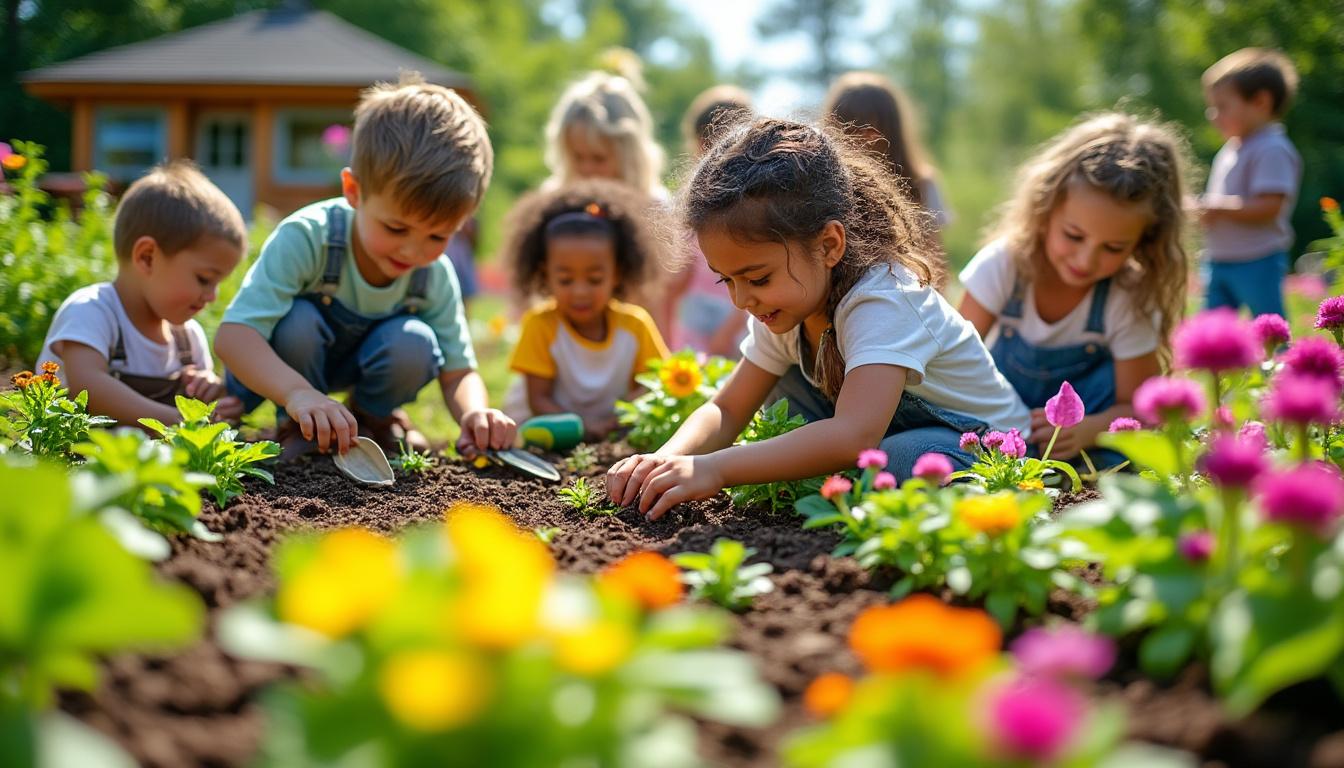In a world increasingly dominated by screens and digital distractions, fostering a connection between children and the natural world has become essential. Cultivating gardens offers more than just a hobby; it instills responsibility, patience, and a profound appreciation for life’s cycles. Encouraging children to create their own gardens transforms outdoor spaces into realms of discovery and growth. By empowering youngsters to nurture their own green corners, parents and educators alike ignite a lasting passion for gardening that extends beyond soil and seeds. This exploration not only nurtures botanical skills but also cultivates vital life lessons and a sense of environmental stewardship that resonates in every aspect of their young lives.
Engaging Children with Personalized Garden Projects to Cultivate Passion
Allowing children to take ownership of their gardening space serves as a decisive factor in developing their enthusiasm. Little Green Thumbs flourish when given the chance to select their own plants, whether flowers or vegetables, tailored to their interests and taste preferences. For example, a child fond of cooking may delight in planting herbs like basil and mint or vegetables such as cherry tomatoes—transforming the garden into a tangible source of meals. Similarly, young enthusiasts of colorful blooms might gravitate towards bright annuals or fairytale-themed miniature gardens, invoking imagination and pride in their care.
Garden Builders can improve participation by introducing child-sized gardening tools and materials, making the experience accessible and enjoyable. Items like small rakes, spades, watering cans, and gloves designed for kids create an inviting environment where children feel capable and motivated. If the family lacks a traditional garden, containers and raised beds, as utilized by Tiny Roots projects, offer manageable alternatives, enabling even apartment dwellers to partake in planting adventures.
Consider the following steps to actively involve children in their gardening journey:
- Plant Selection: Visit local nurseries or botanical events encouraging children to choose seeds or seedlings they find appealing.
- Personal Garden Plot: Allocate a defined area—whether a 3-square-foot patch or a decorative planter—labeled with their chosen garden name to foster a sense of responsibility.
- Creative Design: Encourage kids to design garden signage and decorate pots, strengthening emotional ties and creative expression.
- Daily Care: Teach watering, weeding, and observing plant growth rhythms, explaining how each contributes to plant health.
This hands-on approach creates a meaningful experience, especially when combined with stories about ecology and plant life cycles. Resources such as children gardening tips provide practical insights for structuring these activities in accessible and age-appropriate ways.
| Step | Purpose | Benefit for Child |
|---|---|---|
| Choose Plants | Engage interest through personal choice | Fosters ownership and care |
| Create Plot | Define responsibility | Builds pride and independence |
| Use Child-friendly Tools | Enable participation | Enhances capability and enthusiasm |
| Daily Maintenance | Teach patience and responsibility | Instills real-world skills |
Integrating Multisensory and Educational Activities to Spark Nature’s Play
Children absorb experiences most deeply when engaging multiple senses. Nature’s Play initiatives champion incorporating tactile, auditory, visual, and even olfactory elements into garden projects. Kids tuning into sounds—like birdsong or rustling leaves—develop enhanced awareness of their surroundings. Likewise, touching textures of soil, leaves, and petals deepens their sensory connection.
Specialized programs, such as Garden Explorers and Young Botanists, often involve interactive activities including:
- Bug Hunting: Observing beneficial insects like ladybugs which contribute to garden health.
- Smell Walks: Engaging with aromatic herbs or flowers to develop olfactory appreciation.
- Color Identification: Using colorful plants to learn about hues and plant biology.
- Artistic Expression: Pressing flowers or creating natural crafts complements gardening with creative outlets.
These multisensory experiences bolster not only knowledge but also mindfulness and emotional well-being. Experimental learning encourages kids to explore independently, fostering critical thinking and a sense of wonder. Explaining plant needs in relatable terms, such as comparing water and sunlight to meals and rest, helps children empathize with their garden’s growth and care requirements.
| Activity | Sensory Engagement | Learning Outcome |
|---|---|---|
| Bug Hunting | Touch, Sight | Understanding ecosystem balance |
| Smell Walks | Smell | Developing sensory vocabulary |
| Color Identification | Sight | Botanical awareness |
| Artistic Crafting | Touch, Sight | Creativity in nature appreciation |
Fostering Nutritional Awareness and Healthy Habits Through Edible Gardens
Growing their own food becomes a powerful motivator for children to engage with gardening. Kid’s Garden Adventure concepts focus on connecting young gardeners with the origins of their meals, positively influencing dietary choices. When children witness the transformation of a seed into a nourishing vegetable or fruit, it enhances respect for food sources and encourages healthier eating.
Projects can focus on easily cultivable, child-friendly vegetables like:
- Carrots
- Lettuce
- Tomatoes
- Radishes
- Herbs such as parsley, basil, and chives
These plants have relatively brief growing cycles, holding children’s interest by offering timely rewards. Additionally, involvement in preparing meals with their own produce reinforces the cycle of care and consumption. Plant Pals programs often incorporate cooking classes, helping youngsters learn to use the herbs and vegetables they tend, making nutrition practical and enjoyable.
Engaging children in garden-to-table experiences also lays the groundwork for lifelong wellness habits. Parents aiming to amplify the benefits of gardening can access specialized gardening passion resources to integrate nutrition education seamlessly.
| Vegetable/Herb | Growing Time | Ideal Conditions | Nutrition Benefit |
|---|---|---|---|
| Carrots | 60-70 days | Loose, sandy soil | Rich in beta-carotene |
| Lettuce | 30-60 days | Cool, moist soil | High in vitamins A & K |
| Tomatoes | 60-85 days | Full sun, well-drained | Source of lycopene and vitamin C |
| Basil | 60 days | Warm weather, regular watering | Contains antioxidants |
Developing Patience, Responsibility, and Environmental Stewardship Through Gardening
Gardening fosters essential qualities in growing children: patience, responsibility, and environmental mindfulness. By tending to their own garden plots, youngsters learn the importance of consistent care and observation, recognizing that immediate results are uncommon. The Sprout House concept emphasizes guiding children through the gradual phases of planting, nurturing, and harvesting, encouraging resilience and perseverance.
Planting calendars and visual reminders help cultivate discipline, enabling children to track growth stages and schedule watering or weeding tasks. Providing gentle encouragement rather than enforcing perfection encourages experimentation and learning from setbacks. For instance, if a child harvests an unripe tomato prematurely, the resulting bitter taste serves as a practical lesson reinforcing the value of timing and patience.
Moreover, Young Botanists programs connect children emotionally with the environment by illustrating the role of gardens in ecosystems and biodiversity. Teaching them about pollinators, composting, and water conservation instills early environmental values. These lessons create a foundation for conscious adulthood, promoting sustainable habits that extend well beyond gardening.
| Trait | Gardening Practice | Life Skill Developed |
|---|---|---|
| Patience | Waiting for plants to mature | Resilience |
| Responsibility | Daily watering and weeding | Consistency and independence |
| Environmental Stewardship | Composting and pollinator support | Ecological awareness |
Creative Gardening Activities and Resources to Enrich Kid’s Experience
Expanding beyond traditional gardening, incorporating imaginative projects deepens children’s engagement. Garden Builders and Plant Pals promote activities like designing miniature fairy gardens, building insect hotels, and creating seasonal themed garden beds. These interactive tasks inspire problem-solving, creativity, and a more profound connection to nature’s cycles.
Furthermore, technology can complement outdoor experiences. Online platforms and newsletters such as those featured at Oxford Farm Gardening Tips and Planting Tips for Different Climates offer engaging educational content accessible for children and adults alike.
The use of collaborative projects within schools or community centers strengthens social skills and community ties. For example, participating in a community garden or group planting event with Kid’s Garden Adventure themes nurtures teamwork and cultural exchange.
- Fairy garden creation to spark imagination
- Insect hotel building to learn about beneficial creatures
- Seasonal planting to understand ecological cycles
- Garden journaling to document progress and reflect
| Activity | Skills Developed | Long-Term Benefits |
|---|---|---|
| Fairy Gardens | Creativity, Planning | Enhanced engagement with nature |
| Insect Hotels | Ecology, Construction | Biodiversity support and learning |
| Seasonal Planting | Agricultural knowledge | Environmental awareness |
| Garden Journaling | Reflection, Writing | Self-expression and observation skills |
For in-depth guides and continuous inspiration on encouraging children’s love for gardening, visit resources such as Kids Garden Passion and Gardening Advice Texas, which provide expert advice and innovative project ideas.
Frequently Asked Questions About Encouraging Children in Gardening
- How can parents accommodate limited space for gardening?
Utilizing containers, raised beds, or vertical gardening techniques allows children to grow plants in confined environments, making garden projects feasible in apartments or areas without traditional yards. - What are the safest plants to grow around young children?
Choose non-toxic plants such as sunflowers, marigolds, or herbs like basil and mint. It’s best to avoid plants with toxic parts like tomato leaves or rhubarb stems unless closely supervised. - How can gardening improve a child’s learning outside school?
Gardening integrates science, math, and environmental studies organically. It helps develop responsibility, observation skills, and patience, complementing academic learning through real-world application. - What are good starter plants for young gardeners?
Fast-growing and resilient species such as lettuce, radishes, and marigolds offer quick results that maintain interest and provide satisfying outcomes. - How can digital tools enhance the gardening experience?
Educational apps, online videos, and interactive platforms can supplement hands-on gardening by offering tutorials, plant identification, and growth tracking, engaging children with multimedia learning.

